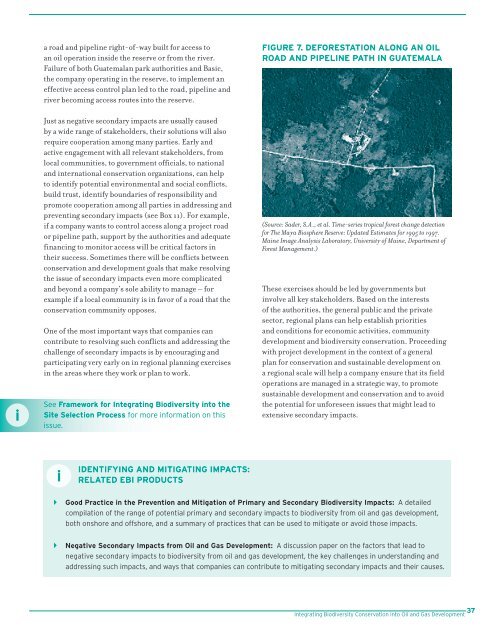Integrating Biodiversity Conservation into Oil and Gas ... - EBI
Integrating Biodiversity Conservation into Oil and Gas ... - EBI
Integrating Biodiversity Conservation into Oil and Gas ... - EBI
Create successful ePaper yourself
Turn your PDF publications into a flip-book with our unique Google optimized e-Paper software.
i<br />
a road <strong>and</strong> pipeline right-of-way built for access to<br />
an oil operation inside the reserve or from the river.<br />
Failure of both Guatemalan park authorities <strong>and</strong> Basic,<br />
the company operating in the reserve, to implement an<br />
effective access control plan led to the road, pipeline <strong>and</strong><br />
river becoming access routes <strong>into</strong> the reserve.<br />
Just as negative secondary impacts are usually caused<br />
by a wide range of stakeholders, their solutions will also<br />
require cooperation among many parties. Early <strong>and</strong><br />
active engagement with all relevant stakeholders, from<br />
local communities, to government officials, to national<br />
<strong>and</strong> international conservation organizations, can help<br />
to identify potential environmental <strong>and</strong> social conflicts,<br />
build trust, identify boundaries of responsibility <strong>and</strong><br />
promote cooperation among all parties in addressing <strong>and</strong><br />
preventing secondary impacts (see Box 11). For example,<br />
if a company wants to control access along a project road<br />
or pipeline path, support by the authorities <strong>and</strong> adequate<br />
financing to monitor access will be critical factors in<br />
their success. Sometimes there will be conflicts between<br />
conservation <strong>and</strong> development goals that make resolving<br />
the issue of secondary impacts even more complicated<br />
<strong>and</strong> beyond a company’s sole ability to manage – for<br />
example if a local community is in favor of a road that the<br />
conservation community opposes.<br />
One of the most important ways that companies can<br />
contribute to resolving such conflicts <strong>and</strong> addressing the<br />
challenge of secondary impacts is by encouraging <strong>and</strong><br />
participating very early on in regional planning exercises<br />
in the areas where they work or plan to work.<br />
See Framework for <strong>Integrating</strong> <strong>Biodiversity</strong> <strong>into</strong> the<br />
Site Selection Process for more information on this<br />
issue.<br />
FIGURE 7. DEFORESTATION ALONG AN OIL<br />
ROAD AND PIPELINE PATH IN GUATEMALA<br />
(Source: Sader, S.A., et al. Time-series tropical forest change detection<br />
for The Maya Biosphere Reserve: Updated Estimates for 1995 to 1997.<br />
Maine Image Analysis Laboratory, University of Maine, Department of<br />
Forest Management.)<br />
These exercises should be led by governments but<br />
involve all key stakeholders. Based on the interests<br />
of the authorities, the general public <strong>and</strong> the private<br />
sector, regional plans can help establish priorities<br />
<strong>and</strong> conditions for economic activities, community<br />
development <strong>and</strong> biodiversity conservation. Proceeding<br />
with project development in the context of a general<br />
plan for conservation <strong>and</strong> sustainable development on<br />
a regional scale will help a company ensure that its field<br />
operations are managed in a strategic way, to promote<br />
sustainable development <strong>and</strong> conservation <strong>and</strong> to avoid<br />
the potential for unforeseen issues that might lead to<br />
extensive secondary impacts.<br />
i<br />
IDENTIFYING AND MITIGATING IMPACTS:<br />
RELATED <strong>EBI</strong> PRODUCTS<br />
4 Good Practice in the Prevention <strong>and</strong> Mitigation of Primary <strong>and</strong> Secondary <strong>Biodiversity</strong> Impacts: A detailed<br />
compilation of the range of potential primary <strong>and</strong> secondary impacts to biodiversity from oil <strong>and</strong> gas development,<br />
both onshore <strong>and</strong> offshore, <strong>and</strong> a summary of practices that can be used to mitigate or avoid those impacts.<br />
4 Negative Secondary Impacts from <strong>Oil</strong> <strong>and</strong> <strong>Gas</strong> Development: A discussion paper on the factors that lead to<br />
negative secondary impacts to biodiversity from oil <strong>and</strong> gas development, the key challenges in underst<strong>and</strong>ing <strong>and</strong><br />
addressing such impacts, <strong>and</strong> ways that companies can contribute to mitigating secondary impacts <strong>and</strong> their causes.<br />
37<br />
<strong>Integrating</strong> <strong>Biodiversity</strong> <strong>Conservation</strong> <strong>into</strong> <strong>Oil</strong> <strong>and</strong> <strong>Gas</strong> Development
















![[PDF] Community Development Toolkit - CommDev](https://img.yumpu.com/48616495/1/184x260/pdf-community-development-toolkit-commdev.jpg?quality=85)
